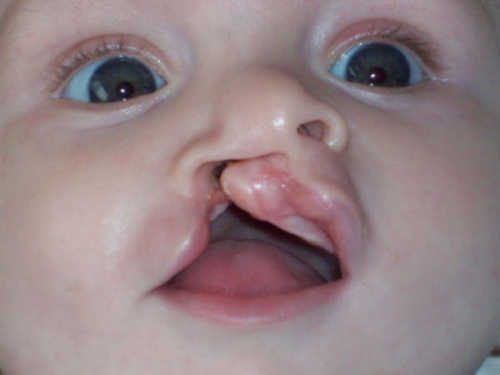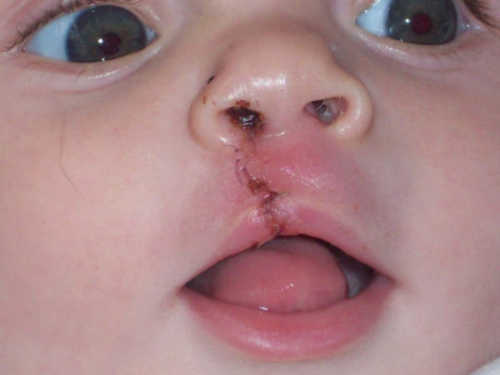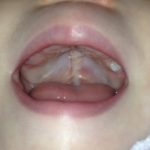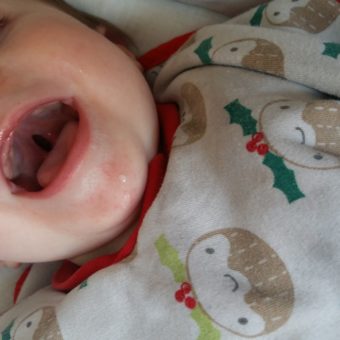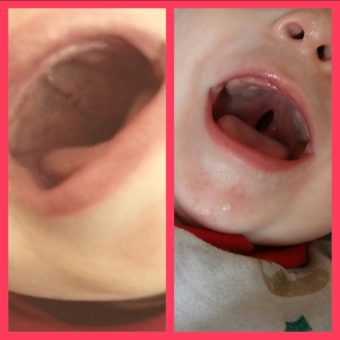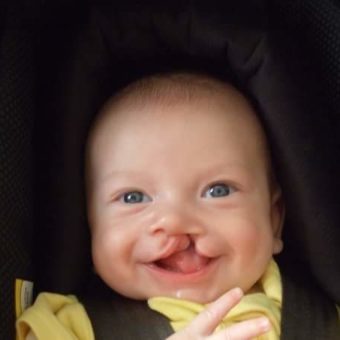
Repair Surgery
This information is for parents and carers of children with a cleft who are going through repair surgery as babies. It is intended to prepare you for what can be a very difficult time for the whole family, and to answer common questions and worries. It is not intended to replace any medical advice from your Cleft Team, and is a general guide only. Your Cleft Team and the specialist surgeon operating on your child will be able to answer any specific questions you have, and these answers will differ between hospitals and between surgeons.
CLAPA’s Gallery of Before & After Surgery Photos
We hope this section is a source of comfort and reassurance. For more support, see our Parent Supporters or our CLAPA Community Facebook Group.
“We’re not going to sugarcoat this. One of the toughest things about having a child with cleft is knowing that when they are under one year old you will have to take them into a hospital to have surgery. They will have to have general anaesthetic, to endure hours on the operating table, and they will be deeply uncomfortable and unhappy when they wake up and for several days or weeks afterwards. It is a real challenge for you as a new parent, and something that we wouldn’t wish on anyone.
However, we survived. Our little ones survived and they amazed us with their bravery and their ability to bounce back. And if we can do it, then so can you and so can your little one.”
– Two mums from South London
VIDEO: Postnatal Care, 2:54
This short video explains what happens in the lead-up to cleft repair surgery and what parents can expect.
What Does Repair Surgery Involve?
Cleft repair surgery involves joining the tissues that did not join together while your baby was in the womb. The aim is for the best possible functional (how it works) and aesthetic (how it looks) outcome as your child gets older.
There are a number of different surgical techniques practiced by cleft surgeons across the UK, so the specifics of the surgical procedure itself may vary, but the results will be largely the same. You may hear things from other parents that are different to what you have been told by the surgical team, but this should not be a cause for concern. The surgeons working in the NHS Cleft Teams are cleft specialists and perform operations on many babies like yours every year, so wherever you are in the UK, you can rest assured that your baby is in good hands. If you have any specific questions or concerns about the procedure, talk to your Cleft Team.
Surgery will be done under general anaesthetic (where your baby is asleep the whole time). One or both parents are usually able to go into the anaesthetic room with your baby and stay until he or she is asleep. This usually involves your baby breathing some gas. Once your baby is asleep, a tube will be passed into their airway to help with breathing, and a cannula (a thin tube) is put into a vein, often in the foot, to help give fluids to your baby during and after surgery if necessary.
There are risks during every surgery, but with the team of experts looking after your baby this risk is very small and carefully managed every step in the way. Talk to the team if you have any concerns.
Cleft Lip Repair
Cleft lip repair surgery takes place when the baby is at least 3 months old.
A cleft lip repair involves reconstructing the shape of the lip and the nose and joining the tissues that were not joined before birth. There are a number of different techniques which depend on the shape of your baby’s cleft and the surgeon’s preference. If the palate is involved, part of it may be repaired at the same time.
Dental impressions may be taken before or during the operation so the team has an accurate record of your baby’s cleft to compare with the future development of their mouth.
Afterwards, some bleeding from the mouth is to be expected, and you may see some stitches, swelling and crusting on the lip. Sometimes a small piece of foam is used to hold the nose in its new shape. Splints are sometimes placed on the baby’s arms to stop them from touching the stitches.
Your baby will look quite different after the surgery, and this can be quite distressing to some parents. Many say that they miss their baby’s ‘old’ smile and that it takes a while to get used to how they look following the cleft repair. Prepare yourself for this as best as you can using our surgery gallery and by reading stories from other parents, and do ask for support if you need it at this time.
The surgery usually takes from 1-2 hours depending on the cleft, but your baby will likely be away from the ward for 2-4 hours.
Babies will usually stay in hospital for one or two nights after the operation, however if the cleft is quite small some babies may even be discharged on the same day.
Passport Photos
If your baby already has a passport before their lip repair, you may need to get a new one shortly after if you plan to travel.
The UK Passport Office has stated there is no formal guidance on this and that they cannot advise parents on their individual cases. Whether or not a passport will be accepted depends on the reactions of the officials at different borders around the world, and if they can easily recognise your child based on their passport photo.
The general advice is that if the change to your baby’s appearance is ‘drastic’ and ‘unrecognisable’, you should get them a new passport.
You’re unlikely to have issues when taking internal flights or leaving the UK, but you could run into problems trying to enter your destination country.
If you have issues entering a foreign country with your baby’s passport, you will likely be pulled aside and given a chance to explain their different appearance. If your child has a visible scar matching the area of the cleft in the photo, and if you have photo records of them being in hospital and receiving their repair surgery, you’re more likely to be allowed through. You will always be taking a chance, however, and it will usually be much simpler to get a new passport than risk being turned away at a border.
Anecdotally, many parents have told us they’ve had no issues travelling with a pre-surgery passport photo for years after the repair and have never had to produce ‘evidence’ of their child’s surgery at a border, but there is no guarantee.
Unfortunately, there are no separate procedures for updating a photo for a reason like this, so you will have to apply for a new passport for your baby in the usual way.
Cleft Palate Repair
Cleft palate repair surgery usually happens between 6-12 months.
The palate (especially the soft palate) is very important for not just eating and swallowing, but also for speech, so a palate repair surgery aims to make sure the palate works as well as possible. It is repaired in layers, with the focus on reconstructing the muscle of the soft palate.
Dental impressions may be taken before or during the operation so the team has an accurate record of your baby’s cleft to compare with the future development of their mouth.
Sometimes, small incisions are made to the side of the cleft to ‘loosen’ the tissue and give the surgeon more to work with, but these will heal very quickly.
“His surgeon had made a small insertion into each side of his mouth which meant that there was more tissue available to pull the soft palate together. When we looked in his mouth there was a lot of sutures, it looked like he had a mini zip on each side if his mouth and a big one up the middle of his palate. But, it was astonishing to look into his mouth and see a complete palate!”
– a parent
As with a cleft lip repair, your child’s mouth will be quite sore afterwards (especially at the corners where the lip has been stretched during the operation), and splints may have been placed on your child’s arms to stop them from touching or picking at any stitches.
